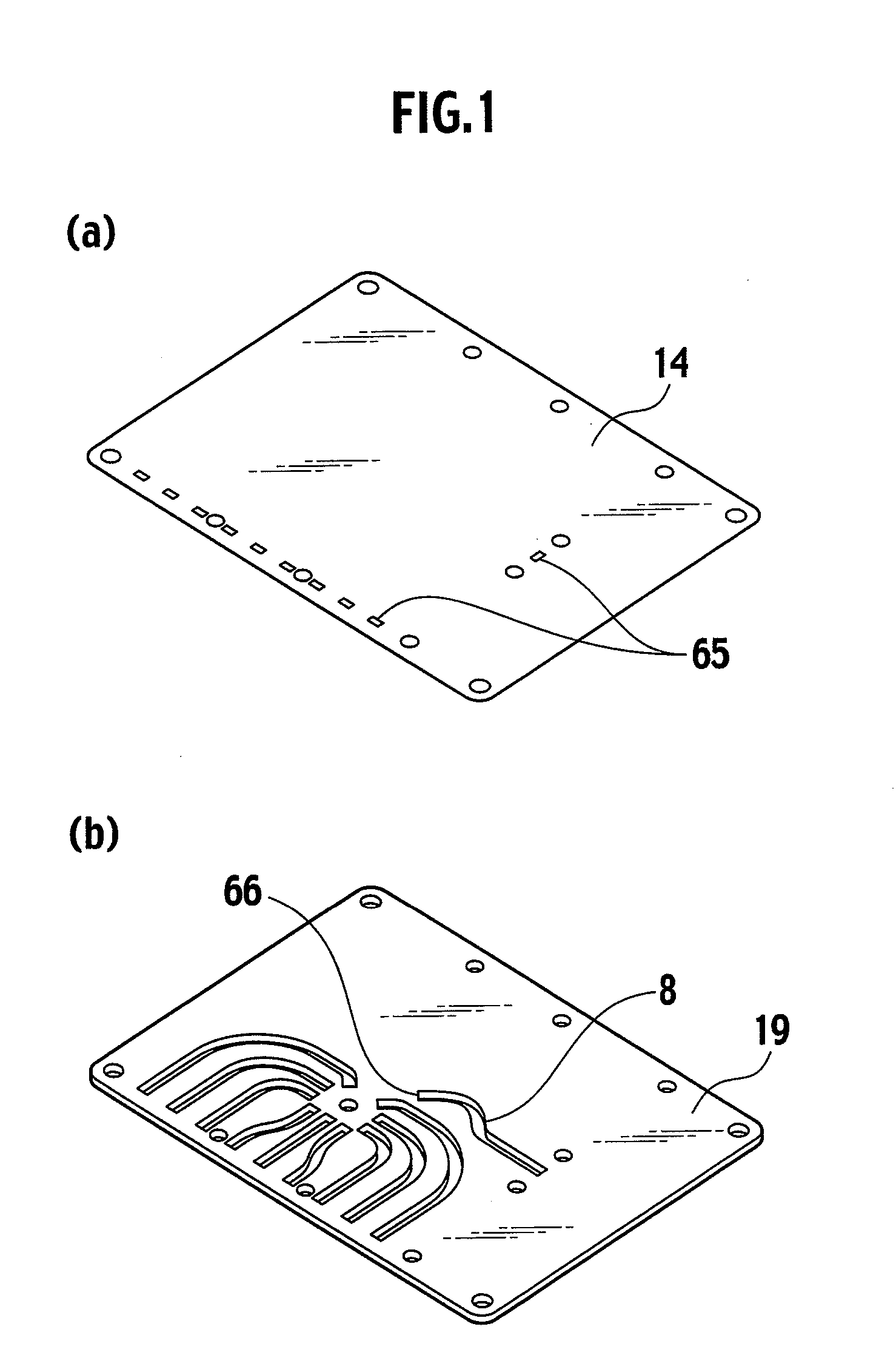Planar Antenna Module, Triple Plate Planar, Array Antenna, and Triple Plate Feeder-Waveguide Converter
- Summary
- Abstract
- Description
- Claims
- Application Information
AI Technical Summary
Benefits of technology
Problems solved by technology
Method used
Image
Examples
first embodiment
[0067] Referring to FIGS. 4, 5, and 7, in the planar antenna module according to the first embodiment of the present invention, the radiation element 41 serves as an antenna element along with the fourth ground plate 14 and the first slot 21 formed in the first ground plate 11 and is able to take in energy having a predetermined frequency. The energy is transferred to the first connection portion 43 by the first feeder 42 formed on the antenna substrate 40. The energy is then transferred to the second feeder 51 because the first connection portion 43 formed in the antenna substrate 40 is electromagnetically coupled with the second connection portion 52 formed in the feed substrate 50 via the second slot 24 formed in the fourth ground plate 14.
[0068] In this case, the first connection port formation portion 22 formed in the second ground plate 12, the second connection port formation portion 23 formed in the third ground plate 13, the third connection port formation portion 25 forme...
example 1
[0077] An example according to the first embodiment is described with reference to FIGS. 4, 5, and 7.
[0078] The first ground plate 11, and the fourth plate 14 were made of an aluminum plate of 0.7 mm thick. The second ground plate 12, the third ground plate 13, the fifth ground plate 15, the sixth ground plate 16, and the seventh ground plate 17 were made of an aluminum plate of 0.3 mm thick. The (circuit) connection plate 18 was made of an aluminum plate of 3 mm thick. The dielectrics 31, 32, 33, 34 were made of foamed polyethylene having a relative permittivity of 1.1 relative to air and a thickness of 0.3 mm. The antenna substrate 40 and the feed substrate 50 were made using a flexible substrate in which a copper foil has been attached on a polyimide film. Specifically, the antenna substrate 40 was made by etching off an unnecessary portion of the copper foil to form the radiation elements 41, the first feeders 42, the first connection portions 43, the second feeders 51, the sec...
second embodiment
[0082] A planar array antenna according to a second embodiment is characterized in that dielectrics 2a, 2b and metal spacers 9a, 9b having the same thickness are provided as a metal shield portion so as to sandwich an antenna circuit substrate 3 therebetween, and dummy slot openings 8 adjacent to a slot opening 7 in a slot plate 4 are provided, as illustrated in FIG. 15(a).
[0083] Another planar array antenna according to this embodiment is characterized in that an arrangement distance of the dummy slot openings 8 concerned is from 0.85 to 0.93 times the free space wavelength λ0 of the center frequency of a frequency band to be used, as illustrated in FIG. 15(b).
[0084] Yet another planar array antenna according to this embodiment is characterized in that dummy elements 10 that are similar to the radiation elements 5 in terms of size are provided on the antenna circuit substrate 3 so that the dummy slot openings 8 are positioned directly thereabove, as illustrated in FIGS. 16(a), 16...
PUM
 Login to View More
Login to View More Abstract
Description
Claims
Application Information
 Login to View More
Login to View More - R&D
- Intellectual Property
- Life Sciences
- Materials
- Tech Scout
- Unparalleled Data Quality
- Higher Quality Content
- 60% Fewer Hallucinations
Browse by: Latest US Patents, China's latest patents, Technical Efficacy Thesaurus, Application Domain, Technology Topic, Popular Technical Reports.
© 2025 PatSnap. All rights reserved.Legal|Privacy policy|Modern Slavery Act Transparency Statement|Sitemap|About US| Contact US: help@patsnap.com



